Rainy spring weather may lead to more leaf spot pathogens in the nursery
Above normal rainfall across west Michigan reminds nursery growers to scout for bacterial and fungal leaf spots on nursery stock. Learn the symptoms and management strategies for both pathogens.
Some locations across west Michigan have had in excess of 10 to 15 inches of rainfall since the first of April. This is considerably above normal for many Enviro-weather stations in the area and will lead to more concerns about foliar leaf spots on deciduous nursery stock in the coming weeks according to Michigan State University Extension. Most leaf spots, either bacterial or fungal, like to be spread around nursery crops with splashing rains and winds. Infections will occur when the plants remain wet for extended time periods. Most infections occur through leaf stomata, young emerging shoots, flower-parts or leaves that are damaged by winds or abrasions.
Nursery growers need to scout plants and look for the early signs of leaf spots and begin a preventative fungicide application as soon as the first symptoms are observed. In some cases, preventative fungicide applications need to go on as soon as leaf unfolding occurs, particularly if you have a history of leaf spots on certain crops like dogwoods, hydrangea and lilac.
Fungal leaf spot symptoms to look for when scouting generally are irregular lesions on leaves, new shoots or stems that are tan, gray and black in color (Photos 1-4) Sometimes, dark-black, “pepper grain-like” structures are observed inside the lesions. These are pycnidia and are the structures that contain spores that spread the fungus to other leaves. New infections can be visible within five to 15 days after the spore germinates and infects plant tissue.
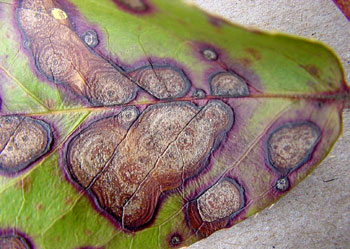
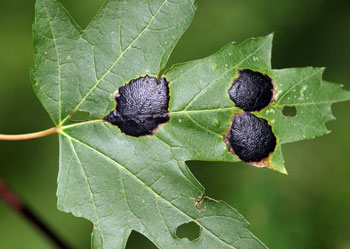
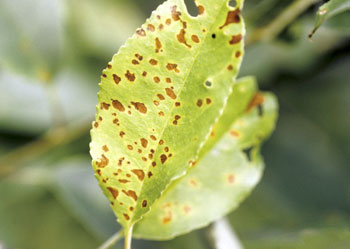
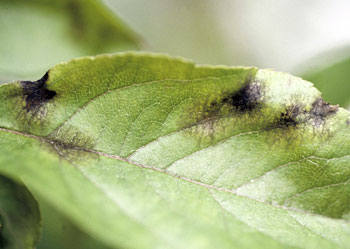
Photos 1-4. Fungal leaf spot symptoms. Photo credits: (top left) Paul Bachi, University of Kentucky Research and Education Center,
Bugwood.org; (top right) Steven Katovich, USDA Forest Service, Bugwood.org; (bottom left) Joseph O'Brien, USDA Forest Service, Bugwood.org; (bottom right)
Joseph O'Brien, USDA Forest Service, Bugwood.org
Examples of leaf spot fungi on deciduous plants include tar spot on maple (Rhytisma spp.), black spot on rose (Diplocarpon rosae), Alternaria leaf spot on Hibiscus, and Phyllosticta on maple and dogwood. Management of these and other fungal leaf spots on deciduous plant material utilize a multi-prong approach including resistant cultivar selection, disease-free planting stock from your supplier, managing moisture, good plant spacing and avoiding excess shading as well as proper plant nutrition and the use of the correct fungicides.
Bacterial leaf spots are caused by a number of bacterial species like Psuedomonas syringae pv.syringae on lilac, Xanthomonas spp. on Hydrangea spp. and others on Prunus spp. They generally cause irregular to circular dark-brown lesions with a yellow halo (Photos 5-6). The small spots coalesce to large lesions. Stems may also be blighted and will die back. The lesions look water-soaked or greasy. Bacterial leaf spots follow the veins of the leaf and the center of the leaf spot may “fall out.”
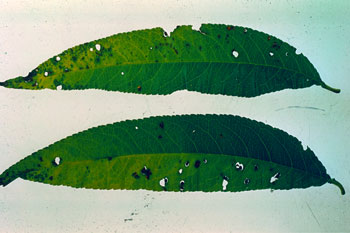
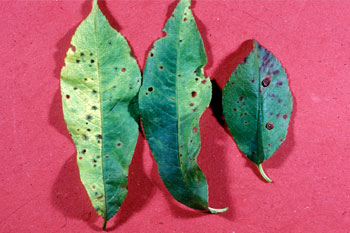
Photos 5-6. Bacterial leaf spot symptoms. Photo credits: (left) H.L. Keil, Bugwood.org and (right) University of Georgia Plant Pathology
Archive, University of Georgia, Bugwood.org
Bacterial leaf spots have lifecycles in which the new infecting bacteria are produced in infected tissue that are spread by wind, pollinating insects, frost or pruning injury and water splashing. The infections occur through wounds in leaf stomata, young shoots, flower parts, etc. Warm, wet weather in the spring and summer are ideal for bacterial leaf spot conditions, although they can occur earlier with plants that are in poly huts. Infected leaves that fall from the plant are a major source of inoculum. Symptoms will show in seven to 21 days after infection.
Integrated pest management strategies for bacterial leaf spots include clean planting stock and resistant cultivars, minimizing overhead watering, good plant spacing for air circulation, scouting for symptoms, avoiding high fertility, cleaning up fallen leaves if an infection has occurred and applying bactericides like coppers in a preventative.
It is critical to obtain an accurate diagnosis of the leaf spot you may have before beginning a treatment program. For accurate diagnosis of leaf spots, send plant samples to the Diagnostic Services Lab on the MSU campus. The lab will be able to identify the pathogen and provide correct treatment recommendations for the particular leaf spot on that plant.
For more information on this subject, contact Tom Dudek at 616 994-4542 or dudek@anr.msu.edu.



 Print
Print Email
Email




